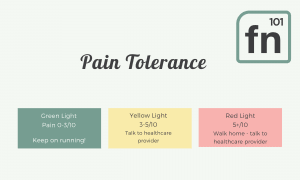RUNNING 101
Alright my people. It’s the start of spring and you’re ready to come out of hibernation and get all the benefits of exercising OUTSIDE. Here are 4 things I talk about with all my clients that are getting into running.

1. FOOTWEAR: It’s imperative that you get a supportive running shoe that works for you. We’re lucky in the Hamilton area to have a bunch of knowledgeable people in the footwear industry. We totally recommend Runners Den (Westdale) or Ten Toe’n Shoes (Dundas), for shoes as they are experienced and big players in the running community in Hamilton. Additionally, feel free to book in with one of our very own, Chris Puddephatt, who is a licensed chiropodist and foot expert!
2. DATA: This can be a controversial topic. What to track? KM’s? Time? Pace? Heart rate (HR)? It depends on what data you have access to. Why track data? It helps keep us GOING!
If you have a watch that measures HR, I would recommend using Maffetone’s Aerobic Fitness (MAF) method. The formula is 180 – age. Meaning you do ALL your training runs at this heart rate. You then slowly increase your distance over time.
Alternatively, if you have access to Strava (we love how this keeps people accountable) or another GPS tracking app, start with a few comfortable runs and progress from there.
Intervals training is an excellent way to gradually ramp up your running from “couch to 5km”, “5km to 10km”, or even just getting back to running safely after an injury. I always start with prescribing some sort of interval 1 min walk 1 min run etc. depending on my client’s training level. Here is a really helpful link that leads you through proper interval training for various levels: https://therunningclinic.com/runners/learn/training-programs/training-programs/
My last piece of advice is to only change 1 variable at a time per run. For example, I may choose to increase my speed but keep the distance the same for one run. Next time, I may choose to stay at a slower pace and increase my milage. This way I can measure my response to the training load for that particular variable and stay within a safe zone of training.
3. STRENGTH TRAINING: Runners have to strength train. I repeat, runners have to strength train. It’s plain and simple. Your body needs to be able to absorb very high loads during a run. To avoid injury our tissues need to have a higher capacity than the load we’re putting on the body. Get out the bands, kettlebells, dumbbells or barbells and get hinging, squatting, and lunging friends. Follow our IG for running exercises and visit our youtube channel for a sweet self assessment of strength + running capacity.
4. PAIN TOLERANCE: Super important. We all know running is a difficult task to do well over a long period of time and that injuries can occur. You need to establish clear rules on your “pain” – this can also mean tightness/achy etc. If your pain is 0-3 we consider that mild pain and we give you the GREEN LIGHT. If your pain is 3-5 we recommend talking to a health care practitioner and to proceed with caution as you’re nearing the YELLOW LIGHT, and sometimes quite possibly the RED LIGHT. If your pain is 5+, stop your run and have a leisurely WALK home :)

I hope this was helpful and after reading you are more committed to running. Obviously the first few runs may not feel amazing. If you dig deep and stick to it for 1 month, you’ll start to make it a habit. Who knows maybe you’ll start enjoying it!
If you have any questions, book in today, send us an email at info@function101.ca or call the clinic at 905-525-0101.
Happy running!
Dr. Eric Nelson (Chiropractor, Strength Coach)



